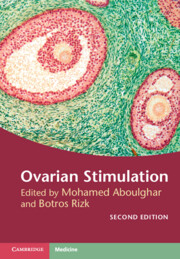Book contents
- Ovarian Stimulation
- Ovarian Stimulation
- Copyright page
- Dedication
- Contents
- Contributors
- About the Editors
- Foreword
- Preface to the first edition
- Preface to the second edition
- Section 1 Mild Forms of Ovarian Stimulation
- Chapter 1 Oral Agents for Ovarian Stimulation
- Chapter 2 Ovulation Induction for Anovulatory Patients
- Chapter 3 Ovarian Hyperstimulation in Combination with Intrauterine Insemination
- Chapter 4 Mild Approaches in Ovarian Stimulation
- Chapter 5 The Case against Mild Stimulation Protocols
- Section 2 Ovarian Hyperstimulation for IVF
- Section 3 Difficulties and Complications of Ovarian Stimulation and Implantation
- Section 4 Non-conventional Forms Used during Ovarian Stimulation
- Section 5 Alternatives to Ovarian Hyperstimulation and Delayed Transfer
- Section 6 Procedures before, during, and after Ovarian Stimulation
- Index
- References
Chapter 1 - Oral Agents for Ovarian Stimulation
from Section 1 - Mild Forms of Ovarian Stimulation
Published online by Cambridge University Press: 14 April 2022
- Ovarian Stimulation
- Ovarian Stimulation
- Copyright page
- Dedication
- Contents
- Contributors
- About the Editors
- Foreword
- Preface to the first edition
- Preface to the second edition
- Section 1 Mild Forms of Ovarian Stimulation
- Chapter 1 Oral Agents for Ovarian Stimulation
- Chapter 2 Ovulation Induction for Anovulatory Patients
- Chapter 3 Ovarian Hyperstimulation in Combination with Intrauterine Insemination
- Chapter 4 Mild Approaches in Ovarian Stimulation
- Chapter 5 The Case against Mild Stimulation Protocols
- Section 2 Ovarian Hyperstimulation for IVF
- Section 3 Difficulties and Complications of Ovarian Stimulation and Implantation
- Section 4 Non-conventional Forms Used during Ovarian Stimulation
- Section 5 Alternatives to Ovarian Hyperstimulation and Delayed Transfer
- Section 6 Procedures before, during, and after Ovarian Stimulation
- Index
- References
Summary
Ovarian stimulation aims at the development of one or more of the ovarian follicles to reach the stage of maturity culminating in the release of one or more mature oocytes ready for fertilization. Ovarian follicular development is under the control of local factors inside the ovaries (most of it is poorly understood), as well as hormones produced from extraovarian sources, mainly pituitary gonadotropins. Other hormones may play a role in ovarian follicular development; the extent and details of such a role are not fully understood.
- Type
- Chapter
- Information
- Ovarian Stimulation , pp. 1 - 14Publisher: Cambridge University PressPrint publication year: 2022



